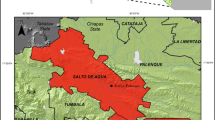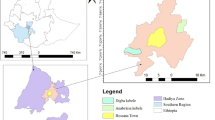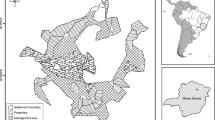Abstract
This paper examines the relationship between farmers’ socio-economic characteristics, silvicultural activity and the quality of their mahogany and kadam plantation stands in two independent case study villages in South Kalimantan Province, Indonesia. Data on farmers’ socio-economic characteristics and silvicultural practices were collected and analysed by village using descriptive statistics, Mann–Whitney tests and Spearman correlations. Mahogany planters with larger areas planted carried out more silvicultural practices. Kadam planters who had joined the farmer’s group earliest, had favourable or highly favourable attitudes towards tree planting, and whose households included more members gaining income were more active in silvicultural management. Approximately half of the studied mahogany and kadam plantations were of high quality. Most of the farmers conducted the recommended silvicultural practices, but just conducting them did not of itself cause the variation in the quality of stands. Pruning timing and recovery time after pruning, however, had an effect on the volume of potentially merchantable wood on medium quality mahogany sites. Further research is required on timing, frequency and methods used for the silviculture in order to improve the quality of stands. The policy implications drawn from this research include that farmers need to be provided with: (a) incentives to plant species with identified markets with reasonable price; (b) motivated extension officers; (c) improved access to production inputs; and (d) structures and mechanisms to assist them to organize and to develop activities, such as joint marketing.


Similar content being viewed by others
References
Amacher GS, Hyde WF, Rafiq M (1993) Local adoption of new forestry technologies: an example from Pakistan’s northwest frontier province. World Dev 21(3):445–453
Arnold JEM, Dewees PA (1997) Farms, trees and farmers: responses to agricultural intensification. Earthscan Publications, London
Bebbington A (1996) Social capital and rural intensification: local organizations and islands of sustainability in the rural Andes. Geogr J 163(2):189–197
Bishwa NR, Garforth C (2004) Problems and prospects of farm forestry. A case of Chitwan district, Nepal. In: Baumgartner DM (ed) Proceedings of human dimensions of family, farm and community forestry. International symposium, March 29–April 1, 2004. Washington State University Extension MISC0526, Pullman
Blundell AG, Gullison RE (2003) Poor regulatory capacity limits the ability of science to influence the management of mahogany. For Policy Econ 5(4):395–405
Byron N (2001) Keys to smallholder forestry. Forests Trees Livelihoods 11(4):279–294
Chaniago Y (2009) Plantation manager, Emida, South Kalimantan (personal communication)
Current D, Lutz E, Scherr S (1995) Costs, benefits, and farmer adoption of agroforestry. World Bank Environment Paper, No. 14. The World Bank, Washington, DC
Deewes PA, Saxena NC (1997) Tree planting and household land and labour allocation: case studies from Kenya and India. In: Arnold JEM, Dewees PA (eds) Farms, trees and farmers: responses to agricultural intensification. Earthscan, London., pp 242–267
Del Lungo A, Ball J, Carle J (2006) Global planted forests thematic study: results and analysis. Planted Forests and Trees Working Paper 38. FAO, Rome
Direktorat Hutan Tanaman Industri (1990) Teknik pembuatan tanaman mahoni. Direktorat Hutan Tanaman Industri, Jakarta
Emila, Suwito (2007) Hutan Tanaman Rakyat (HTR) Agenda baru untuk pengentasan kemiskinan? Warta Tenure 4:14–19
Emtage NF, Suh J (2004) Socio-economic factors affecting smallholder tree planting and management intentions in Leyte province, Philippines. Small-scale For Econ Manag Policy 3(2):257–271
Enters T, Durst PB, Brown C, Carle J, Mckenzie P (2004) What does it take? The role of incentives in forest plantation development in Asia and the Pacific. Asia-Pacific Forestry Commission, Regional Office for Asia and the Pacific, FAO, Bangkok
Filius AM (1997) Factors changing farmers’ willingness to grow trees in Gunung Kdul (Java, Indonesia). Neth J Agric Sci 45(2):329–345
Gunasena HPM, Roshetko JM (2000) Tree domestication in Southeast Asia: results of a regional study on institutional capacity, International Centre for Research in Agroforestry (ICRAF) Bogor
Haltia O, Keipi K (1999) Financing forest investment: the issue of incentives. In: Keipi K (ed) Forest resource policy in Latin America. Inter-American Development Bank, Washington, DC, pp 63–78
Lionberger HF (1960) Adoption of new ideas and practices. Iowa State University Press, Ames, IA
Mahapatra AK, Mitchell CP (2001) Classifying tree planters and non planters in a subsistence farming system using a discriminant analytical approach. Agrofor Syst 52(1):41–52
Martawijaya A, Kartasujana I, Mandang YI, Prawira SA, Kadir K (1981) Atlas Kayu Indonesia (Indonesian wood atlas), vol 2. Forest Products Research and Development Centre, Bogor, pp 55–59
Mercer DE (2004) Adoption of agroforestry innovations in the tropics: a review. Agrofor Syst 61(2):311–328
Mindawati N, Tata MHL (2001) Aspek silvikultur jenis khaya, mahoni dan meranti. In: Parthama IBP, Sukandi T, Santoso E, Mindawati M (eds) Prosiding Pengembangan Jenis Tanaman Potensial (Khaya, Mahoni, dan Meranti) untuk Pembangunan Hutan Tanaman: 42–46. Ekspose Hasil-hasil Penelitian, December 6, 2001. Pusat Penelitian dan Pengembangan Hutan dan Konservasi Alam, Bogor
Nawir AA, Santoso L (2005) Mutually beneficial company-community partnerships in plantation development: emerging lessons from Indonesia. Int For Rev 7(3):177–192
Nibbering JW (1999) Tree planting on deforested farmlands, Sewu Hills, Java, Indonesia: impact of economic and institutional changes. Agrofor Syst 46(1):65–82
Ranta E, Rita H, Kouki J (1994) Biometria: tilastotiedettä ekologeille, 5th edn. Yliopistopaino, Helsinki
Ravindran DS, Thomas TH (2000) Trees on farms, stores of wealth and rural livelihoods—insights and evidence from Karnataka, India. Int For Rev 2(3):182–190
Redford K, Padoch C (eds) (1992) Conservation of neo-tropical forests: working from traditional resources use. Columbia University Press, New York
Salam MA, Noguchi T, Koike M (2000) Understanding why farmers plant trees in the homestead agroforestry in Bangladesh. Agrofor Syst 50(1):77–93
Scherr SJ (1997) Meeting household needs: farmer tree-growing strategies in western Kenya. In: Arnold JEM, Deewes PA (eds) Farms, trees and farmers: responses to agricultural intensification. Earthscan, London, pp 141–169
Scherr SJ (2004) Building opportunities for small-farm agroforestry to supply domestic wood markets in developing countries. Agrofor Syst 61–62(1):357–370
Simmons CS, Walker RT, Wood CH (2002) Tree planting by small producers in the tropics: a study of Brazil and Panama. Agrofor Syst 56(2):89–105
Situs Resmi Pemerintah Kabupaten Tanah Laut (2009) Available at: http://tanahlautkab.go.id/Kondisi-wilayah/ (Accessed 15 Sep 2009)
Soerianegara I, Lemmens RHMJ (1993) Plant resources of South-East Asia 5(1): Timber trees: major commercial timbers. Pudoc Scientific Publishers, Wageningen
Suharlan A, Sumarna K, Sudiono J (1975) Tahel regakan sepuluh jenis Kayu industri. Laporan Lembaga Penelitian Hutan, Bogor
Summers PM, Browder JO, Pedlowski AM (2004) Tropical forest management and silvicultural practices by small farmers in Brazilian Amazon: recent farm-level evidence from Rodonia. For Ecol Manag 192(2–3):161–177
Tyynelä T, Otsamo A, Otsamo R (2002) Changes and alternatives in farmers’ livelihood planning in an industrial forest plantation area in West Kalimantan, Indonesia. For Trees Livelihood 12(4):257–281
Van Noordwijk M, Budidarsono S, Sakuntaladewi N, Roshetko JM, Tata HL, Galudra G, Fay C (2007) Is Hutan Tanaman Rakyat a new paradigm in community based tree planting in Indonesia? ICRAF working paper no 45. ICRAF, Southeast Asia
Varmola MI, Carle JB (2002) The importance of hardwood plantations in the tropics and sub-tropics. Int For Rev 4(2):110–121
Walters BB, Cadelina A, Cardano A, Visitacion E (1999) Community history and rural development: why some farmers participate more readily than others. Agric Syst 59(2):193–214
Walters BB, Sabogal C, Snook LK, de Almeda E (2005) Constraints and opportunities for better silvicultural practice in tropical forestry: an interdisciplinary approach. For Ecol Manag 209(1–2):3–18
Acknowledgments
This paper uses data collected in the collaborative research project ‘Strengthening Rural Institutions to Support Livelihood Security for Smallholders Involved in Industrial Tree-planting Programs in Vietnam and Indonesia’, financed by the Gesellschaft für Technische Zusammenarbeit on behalf of the government of the Federal Republic of Germany. We thank the staff of the Forestry Research Institute of Banjarbaru—particularly Didik Purwito, Marinus Kristiadi Harun, Idin Saefudin Ruhimat, Abdul Kodir, Supriyadi, Aditya Noor Robby, Dian Cahyo Buwono, Dian Lazuardi and Sofyan Agus—for the great help in data collection. We also thank Entin Hendartin and Nani Djoko for assistance in data collection, Philip Manalu, Ramadhani Achdiawan, and George Schoneveld for advice with the data analysis, and Maria Brockhaus, Nick Hogarth, Edith Johnson and Riitta Kallio for their comments on the manuscript.
Author information
Authors and Affiliations
Corresponding author
Rights and permissions
About this article
Cite this article
Kallio, M.H., Krisnawati, H., Rohadi, D. et al. Mahogany and Kadam Planting Farmers in South Kalimantan: The Link Between Silvicultural Activity and Stand Quality. Small-scale Forestry 10, 115–132 (2011). https://doi.org/10.1007/s11842-010-9137-8
Accepted:
Published:
Issue Date:
DOI: https://doi.org/10.1007/s11842-010-9137-8




